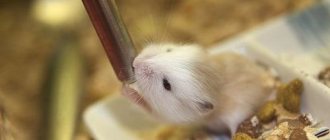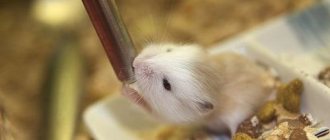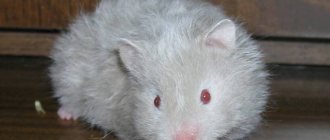Hamsters are common pets. They are distant relatives of mice and rats. Their small size and cleanliness make them easy to care for.
Hamsters make good pets for children or beginners. They are affordable pets, but it is important to consider their short lifespan before purchasing.
Syrian hamsters are the most popular pet hamsters. Various dwarf and long-haired hamster breeds are also common. Some types of hamsters may be more suitable for your family than others.
Who are they?
In simple terms, hamsters are animals of the subfamily of rodents of the hamster family. They differ from their close relatives of mice in their small build, short tail process, small and rounded ears, as well as cheek pouches in which individuals of this species store and carry food.
The external characteristics of hamsters can vary significantly depending on the variety. Approximate description: body length from 5 to 30 centimeters, weight from 30 to 500 grams. Thanks to breeding research, the color is also varied - from solid white, blue, black and red shades to brown flowers with an original pattern on the back or chest.
In their natural environment, representatives of this breed can be found in many regions of Eurasia, China and Korea. These animals live mainly in open spaces of steppes and deserts.
Unlike their relatives, some types of hamsters can be trained and trained. In addition, like many other animal species, hamsters are capable of hibernating during periods of cold and lack of food.
Nutrition
The hamster, of course, does not eat much, and a package of special food will last you for a month. Don’t go cheap, cereals alone (90 rubles per package) are not enough for him - buy food that also contains nuts and dried fruits (230-250 rubles in Kemerovo pet stores).
In any pet store, in addition to regular food, you can buy hamster treats - cookies or various kinds of bars. But this is not necessary - “live” vitamins are no worse. We don’t include this in our expenses: after all, we buy fruits and vegetables for ourselves, which means that the hamster will also get it – how much does he need?
see also
Keeping hamsters at home: advantages and disadvantages
Before getting a pet hamster, familiarize yourself with the basic characteristics of this animal. In nature, there are several breeds of this species; among pets you can mainly find Siberian hamsters, less often - Djungarians and Campbell's hamsters.
The peculiarity of hamsters is that they can feel good without other similar individuals. You can purchase them if you don’t want to breed hamsters in the future.
The advantages of keeping hamsters at home are:
- unlike the same cats, they are not vindictive and do not remember the insults caused;
- do not create noise in the apartment;
- easy to train;
- when eating juicy food, they may not want to drink for a long time;
- easy to reproduce at home;
- do not show dissatisfaction when playing with children;
- a small terrarium is enough for living;
- unpretentious in food.
However, you should be aware of the following difficulties when purchasing hamsters:
- if hamsters are not kept in a terrarium, they can ruin things and chew furniture, shoes and other things;
- so that there is no unpleasant smell in the cage, you need to constantly clean it;
- In winter, hamsters hibernate, sometimes they wake up, then they need to be well fed;
- sometimes they can show aggression.
As a rule, hamsters have a body length from 5 to 30 cm. The color of hamsters can be different:
- ashen;
- grey-brown;
- with a dark stripe on the back and black-brown heels in front of the body;
- white and fluffy (artificial Angora breeds).
More physical activity!
The hamster is kept in abundance of food when living as a pet. Whereas in nature no one cares for him, and he is forced to run up to 12 kilometers a day in search of food! If you do not take care of his physical shape, you will soon become obese along with a “bouquet” of concomitant diseases.
You need to keep a hamster with the following “simulators”:
- Wheel
- Labyrinth
- walking ball
The labyrinth is a good option for daily training.
Habitat
The hamster will delight with its presence and will not cause problems for the owners if you make sure that the habitat is completely suitable for the animal.
Caring for a hamster at home is easy if you immediately buy a house for it and equip it with everything you need.
The cage should be spacious enough. When purchasing, pay attention to the location of the rods. They should be placed horizontally so that the hamster feels free at home and can climb the walls to any height.
The minimum dimensions are 30x50 cm, height 25 cm. If the cage is larger, the pet will only be happy with it.
Instructions for caring for hamsters include the correct choice of location for the cage:
- comfortable room temperature for the animal is from 20 to 24 degrees;
- direct sunlight should not fall on the cage;
- It is unacceptable to place the animal near heating boilers and radiators;
- it is dangerous to place the house in a draft;
- noise from TV and other devices should not disturb the pet;
- the cage must be positioned so that small children and pets cannot reach it;
- the room should be easily ventilated.
When choosing a place for the animal, you need to take into account that younger family members can also care for the hamster. Another feature: the rodent likes to sleep during the day, and at night it becomes active and makes noise.
Sometimes they get out of the situation and place the hamster in an aquarium or a three-liter jar. An aquarium (without water) can be adapted if it is spacious, which cannot be said about a jar. For a rodent, such housing can only be used while the cage is being cleaned.
Basic rules for choosing a cell
The hamster will have to buy a cage in any case. Few people agree that their pet can walk freely in an unsecured playpen, for example, and be able to get out of it if they really want to. When choosing it, you should pay attention to such points as:
- size – the bigger the better;
- the presence of already installed drinking bowls, feeders, wheels;
- metal used to make rods;
- the presence of a strong latch on the door;
- the presence of a solid bottom in the cage or a removable tray;
- presence of paint on metal rods.
Adequate consultants in pet stores will be able to tell you in detail what you need to pay attention to first in order to create adequate conditions for keeping a hamster.
What to feed hamsters at home?
Rodents in nature have learned to survive by eating both grain foods and animal products. They subconsciously avoid harmful plants or poisonous insects, avoiding poisoning. In apartments, pet owners are tempted to give their little ones pieces of food from the table in order to please the pet, which sometimes causes irreparable harm to them. When asking what you can feed hamsters at home, be careful; it is advisable to know exactly the foods prohibited for these animals.
Plant foods allowed for hamsters:
- ready-made dry diets for hamsters,
- sprouted grains of oats, wheat, other cereals,
- different types of nuts (hazelnuts, walnuts, peanuts),
- sunflower and pumpkin seeds,
- cherries, gooseberries, blueberries, other berries,
- pieces of vegetables processed in boiling water without salt,
- raw vegetables and fruits,
- peas in pods or grains,
- a small amount of rose hips and celery,
- Jerusalem artichoke fruits,
- dried fruits,
- branches of deciduous trees,
- greenery.
Allowed animal products:
- fermented milk products (cheese, cottage cheese, unsweetened yogurt) with a fat content of up to 1%,
- boiled chicken meat without spices,
- boiled eggs,
- boiled low-fat fish,
- in rare cases, pieces of peeled shrimp,
- worms and insects purchased from pet stores.
Domestic hamsters can easily tolerate care and maintenance at home, but for them there is an extensive list of prohibited foods:
- potato,
- fatty cheeses,
- ready-made bird feed,
- fresh bread,
- acorns,
- red beans,
- brazil nuts,
- any spices,
- fresh milk,
- garlic with onions,
- cabbage causes gas in hamsters,
- muesli,
- fried food,
- tropical fruits,
- honey,
- mushrooms,
- sweet cookies,
- wild-caught insects and bloodworms,
- tulip bulbs,
- chocolates,
- ice cream.
Feeding
The diet of hamsters provides for 3-4 meals a day during the day, and the second feeding of the day should be as high in calories as possible. The basic component in the diet of rodents is ready-made grain food, which can be purchased at a pet store.
In addition to the main dry food, the rodent's menu should contain food with a protein component and juicy components. When creating a diet for a hamster, it is important to consider that the following list of foods is strictly prohibited for rodents:
- Almonds, acorns, Brazil nuts, cherry and apricot pits, watermelon seeds.
- White and black bread, breakfast cereals and sweet muesli.
- Beans and bean sprouts.
- Dried fruits and candied fruits.
- Vegetables such as cabbage, potatoes, garlic and onions.
- Coniferous branches.
- Spicy herbs, wild garlic and spices.
- Any exotic fruits.
- Sausages, sausages.
- Cheese, sour cream and butter.
Sausages
Animal protein should be given to the hamster no more than 3 times a week; allowed foods include boiled chicken, eggs, natural low-fat yogurt, and boiled low-fat fish.
Hibernation or torpor
Hamsters can hibernate for a variety of reasons. This usually happens due to a sharp drop in temperature and lack of water. The rodent's body becomes hard and cold, and its breathing becomes rare and uneven.
If “wintering” began at an unexpected time or the rodent clearly did not prepare for it (did not make supplies and did not build a nest), be sure to wake it up. Otherwise, he may die from starvation and dehydration. In this case, we are not dealing with natural hibernation, but with torpor. To do this, place the animal in a warm place. For example, you can wrap him in a towel and pick him up. Do not block the access of air, that is, do not wrap the muzzle! Do not place it near heating devices or fire. When he wakes up, he will begin to tremble and stretch. Continue heating until your body temperature rises and your breathing rate returns to normal. Typically, the entire awakening process takes from 30 minutes to an hour.
Analyze what caused the numbness. Maybe the cage was drafty or you didn't give the animal enough food and water? Avoid making these mistakes in the future, as frequent numbness can pose a serious threat to your health.
Inventing entertainment
Of course, the hamster always has a lot to do in his cage, but sometimes he needs some extra entertainment. You can buy him toys or make him a real amusement park that you can use while walking.
Prepare:
- several toilet paper tubes and paper towels;
- empty plastic bottles;
- empty cardboard boxes of different sizes;
- cardboard;
- cardboard scissors or linoleum knife.
How to build an amusement park?
First, think about what it will look like. Lay out all the materials on the floor or make a sketch. Now start assembling.
Make a slit in the center of one of the pipes. Connect some of the pipes to each other, and insert some into boxes. Cut round holes in the top of some of the tubes. They are needed so that the hamster can stick out of the holes. Close the system of pipes and boxes to each other.
Make sure that there is enough space in the pipes for the animal - otherwise it will not fit there.
Don't forget about safety!
- Look for boxes that are missing writing or graphics. The animal will probably gnaw on them, and the paint may give you a stomach ache.
- Do not use glue or tape. They can stain fur and are very dangerous if ingested.
- If you don't want to bother with cardboard, assemble the entire structure from plastic. Sections of sewer pipes are excellent for this purpose. They are easy to attach to each other. Show your imagination, and your pet will definitely thank you.
For the convenience of walking your hamster outside, you can purchase a hamster leash.
Additional cage accessories
The hamster's cage can be equipped with many other accessories and devices that will make your pet's life many times more interesting, active and exciting. Hamsters are very restless animals that are always busy with something.
Did you know? Hamsters are capable of stuffing their cheek cavities with food equal to 1/2 the animal's weight! To empty the bags of supplies, the animal begins to blow intensely - the food flies out at speed, and its cheeks deflate.
Therefore, your pet needs an abundance of various devices to save him from boredom:
- stairs. The pet will be able to climb and exercise on them. You can buy a ladder or build it yourself from wooden ice cream sticks, for example. The main thing is to choose non-toxic glue;
- hammock. At first glance, this item may seem useless to you, but in practice it can become a favorite place for your pet. You can swing your hamster in a hammock, where he can rest or sit out while cleaning the cage. And if the hammock is also equipped with ropes, rings, cables, rest assured that the hamster will rarely get off of there. Like a ladder, you can make a hammock yourself from mesh, fabric, yarn;
- swing. This can be a classic version or a balance swing. You can also make it yourself;
- labyrinths. They will help satisfy the natural curiosity of animals. You can make them from toilet paper rolls, paper towels, or buy ready-made ones;
- toys. These can be various products made of wood (vines) in the form of fruits, dumbbells, cubes, which the pet can move from place to place, gnaw and hide.
Features of caring for pet hamsters
Like most other animals, pet hamsters can be stressed. As a rule, their causes may be the following circumstances:
- changes in the animal's daily routine;
- lack of water;
- external control over his offspring;
- the presence of lighting in the cage where he sleeps;
- introducing another animal, even a hamster.
Also, in order to prevent stressful situations for your hamster, do not talk loudly or scream when near his cage, do not make any sudden movements in this place so that the animal does not feel danger. If you speak to your hamster quietly and calmly, he will behave accordingly.
Also consider the following tips for caring for pet hamsters:
- The hamster must be moved to another cage using a special tube. First he is nudged by hand so that he can explore a new place;
- You need to care for your hamster's teeth carefully and on an ongoing basis. If he eats food that is not too solid, then his teeth grow very quickly , and this interferes with normal food intake;
- The cage should be cleaned several times during the week. During cleaning, the hamster is pulled out of the house and transferred to another place, for example, into a prepared jar. The bedding is changed and the cage is washed with detergent. The toilet area should be cleaned regularly as it gets dirty;
- The hamster needs to be walked regularly. For this purpose, a special playing place will be equipped. You can make obstacle courses, mazes and something similar. At the same time, all sharp objects must be removed from the resting place, and nearby pieces of furniture and decor must be as durable as possible in terms of stability;
- You need to regularly monitor the animal’s claws, especially if it has reached a certain age. Nails are trimmed using special manicure scissors. Do not use a nail file; your hamster may get scared and hurt himself. If the pigmentation of the hamster's claws is weak, they are trimmed only in daylight or table light. If injured, during this procedure, the paw is wrapped with a bandage, and the cage itself is washed so that the wound does not become infected;
- Hamsters do not like water very much, so bathing unless necessary is not recommended. But if you still need to bathe the hamster, be careful not to let water get into its ears, eyes or nose. Don't let the hamster out of your hands so that he doesn't bite you. You need to bathe the animal only if it is very dirty, using rabbit shampoo for this purpose. After bathing, hold your hamster in your hands for a while to warm it up, and then wrap it in a soft towel.
Housing issue
Before buying a hamster, you need to prepare a place for its future keeping. Purchasing glass jars or aquariums for these purposes is a common mistake. Such housing will not be comfortable for a rodent, and also interferes with normal air circulation.
The best option for living a furry pet is a cage, the dimensions of which will be at least 50 cm long and 30 cm wide for one individual. The rods must be positioned horizontally with a minimum distance between them.
Eating food with a funny hamster
The cage must be equipped with the following accessories:
- Feeder. Preference should be given to ceramic options, but you can also opt for plastic models. It is advisable that in one cage there are two feeders at once: one for dry food, the second for wet food.
- Drinking bowl. It is a special design for rodents. Hamsters easily adapt to hanging drinkers with a special rod, which allows them to always have access to clean water. There is no point in pouring water into a bowl, since the hamster will quickly contaminate it with filler and pieces of food during its vigorous activity.
- Filler. The use of sawdust or special wood filler is a prerequisite for comfortable keeping a hamster. The granules can easily cope with unpleasant odors by absorbing animal urine.
- Mineral stone. Necessary for sharpening cutters.
- Running wheel. This accessory is necessary for hamsters due to their increased activity. The surface of the treadmill must be solid to avoid injury to the animal.
It is necessary to change the litter in the cage regularly, since it is useless to train a hamster to go to the toilet in one place in the tray. Constantly replacing the bedding will avoid the appearance of an unpleasant odor and help keep the animal’s home clean.
It is advisable to locate the cage away from drafts, beds and children’s play areas. It is important to determine once and for all a place for the animal to live, since hamsters tolerate any changes very painfully.
If desired, you can equip the animal’s cage with a wooden house, which will serve as a shelter for it from the outside world and become a place to sleep.
What else should you consider when keeping a hamster in your home?
To keep your hamster calm and not experience stressful situations, remember the following:
- house him separately from other hamsters;
- provide the hamster with peace and quiet;
- You should not show your hamster other pets;
- clean your hamster's house when he doesn't see it;
- do not interfere with his lifestyle;
- never punish hamsters;
- do not take it outside or let it on the grass; direct sunlight is especially dangerous for it; it can die in just a few minutes.
If you plan to not only keep, but also breed hamsters at home, then this will not be too difficult. They are capable of producing regular offspring and independently feed up to ten broods throughout the year. To do this, the mother hamster needs to create appropriate conditions - ensure peace and not be taken out of the cage during pregnancy.
As you can see, keeping pet hamsters in an apartment is not so difficult. If all necessary conditions of maintenance and care are observed, this animal will delight you and especially your children for a long time, who will play with hamsters with great pleasure.
Proper house equipment
Having chosen a suitable home for your hamster, you should definitely equip it with:
Read also: There is no news on Instagram, what should I do?
- You need two feeders for rodents. Dry grainy food will be poured into one of them, and natural food in the form of fruits, vegetables and other delicacies will be poured into the other. It is not recommended to place the feeder on the floor. It is best to secure them to rods.
- It is better to choose a nipple drinking bowl for a rodent. It is a closed container with a ball-shaped nipple. To drink, the hamster will have to press the ball with its tongue. In such drinking bowls the water will always be fresh and clean. If you put an ordinary cup, a restless pet can easily knock it over . As a result, the floor in his home will always be wet. In addition, in open containers, water quickly becomes contaminated with food, excrement and various debris.
- Hamsters prefer to sleep in burrows, which can be made from corn filler or sawdust. As a last resort, you can use old newspapers or toilet paper. Materials that absorb unpleasant odors should be used. Therefore, it is not recommended to use rags and cotton wool.
- a place for the toilet himself. When caring for a pet, its toilet will need to be cleaned daily, since the rodent will not relieve itself in a dirty place, and will look for another area for this. As a result, his entire house will be dirty.
- Hamsters are very active, so their cage should be equipped with a running wheel. You can buy such a device at a pet store. You should choose a plastic product, since iron rods can injure your pet’s paws. If there are only wheels with iron bars, then they are covered with cardboard.
- The hamster's house should have a mineral stone, which is an additional nutritional element. The rodent will use it to clean and sharpen its teeth, while simultaneously receiving minerals for its body. The stone can simply be placed on the floor of the cage or tied to the bars.
Hamsters for home keeping
There are several common types of these animals, slightly different in size and coat color. The smallest is the Roborovsky hamster with a body size of up to 6 cm, and an ordinary hamster will grow up to 30 cm in length. Only 3-4 species are popular among amateurs, but there are up to 60 of them in nature. Proper care of a hamster is needed regardless of its origin.
Djungarian hamsters care and maintenance
Dzungariks with a black stripe along the ridge are popular and best studied; their backs are brownish-gray and ocher-gray in color. This species originates from the countries of Asia and Western Siberia; with good care, the animals grow to a size of 10 cm. Caring for Djungarian hamsters at home is simple; they are kept in cages on sawdust; when cleaning the nest daily, no smell is heard. It is recommended that pets be housed in pairs and allowed to breed from 3 months of age.
Syrian hamster content
At first, Syrian (golden) hamsters were bred for laboratories. Soon, the meek, reddish-sandy animals up to 18 cm in size were liked by fanciers, and they began to be intensively bred for home keeping and care. They love temperatures of about 22° C, and when it gets cold they can go into torpor. When it comes to the question of how long Syrian hamsters live at home, these rodents are no different from their counterparts, delighting us with their company for an average of 2-3 years.
Angora hamster care and maintenance
In the natural environment, there is no separate breed of Angora hamsters; they are a unique variety of the common Syrian hamsters, differing from their relatives in their incredibly beautiful fluffy coat of different colors. It is not uncommon for angora litters to produce babies with smooth and fluffy fur. The color of their back is varied - white, gray, tortoiseshell, spotted, silver. This hamster requires simple care at home without complex nuances.
Siberian hamster care and maintenance
Externally, Siberian hamsters are similar to Djungarians, but their backs are a little lighter in color. In winter, their fur becomes noticeably white, which is why they are often called Russian white dwarf hamsters. They live in the steppes of Tuva on flat and hilly terrain. Siberian hamsters are not demanding in terms of care, and their habits do not differ significantly from other species. These pets love to have fun washing themselves and cleaning their fur; when cold weather sets in, they burrow into the bedding.
How to determine gender?
Determining gender is important not only when choosing a name for an animal, but also if you want to keep several animals at once (whether you want to breed them or not). To determine the age of an animal, you must first calm it down. To keep the animal relaxed, avoid sudden movements; you can give it some kind of treat to distract attention from the examination .
To make it easier to examine, slightly lift the animal by the fold of skin between the shoulder blades on the back. In males you will immediately notice the genitals, in females you can find nipples in the chest and abdomen. Judging by the reviews of inexperienced owners, sometimes it is difficult to determine sexual characteristics due to the hair, in this case you should not pull the skin too much, just slightly moisten the animal’s fur in the chest area with warm water - and you will be able to clearly see the genitals. If the animals are very young or newborns, then the sex can be determined by the distance between the anus and urinary opening.
In girls they are located close to each other, in boys they are slightly further apart.
Features of reproduction
In hamsters of any species, the period of maturity begins quite early - in some cases, already after reaching the age of one month. If breeding is not obligatory or urgent for you, then it is recommended to wait up to 5 months. It is at this age that hamsters reach full sexual maturity.
For mating, you should choose active and strong males, as well as healthy and energetic females. The mating itself should take place on neutral territory for each individual, only in this case it will not bring discomfort to the individuals. The best time for mating is in the evening. It is in the evening that the animal’s energy increases, as does sexual activity.
If mating was successful, within a week you will begin to notice characteristic signs of pregnancy: swelling of the nipples, weight gain, decreased activity, the need for more water and food, and possible irritability in the female. Approximately 3-4 weeks after mating, cubs are born; there can be from 1 to 15 or even 18 in a litter, depending on the variety.
Over the course of a year, the average female is capable of bearing litters up to 3-4 times; these animals are extremely fertile.
To save the young, the male should be placed in another cage immediately after birth, otherwise he may simply eat the young individuals. The female should be treated with extreme caution during the period of feeding and rearing. Try not to irritate the animal with games and entertainment; at this time the female needs peace and a large amount of vitamins more. The cubs can be moved to another cage when they reach one month.
Diseases and their prevention
Unfortunately, any type of hamster is extremely vulnerable to many colds and infectious diseases. Some of these diseases extremely weaken the animal's body, which can ultimately lead to its death. Including a certain part of the diseases will be caused by improper conditions of detention, and not by the breed characteristics of the species.
Remember that the best medicine for your pet is timely contact with an experienced veterinarian, avoid self-medication.
We list the most common ailments of hamsters.
- Obesity . A common disease among all pets. The reasons are irregular and plentiful feeding together with a sedentary lifestyle. That is why keeping hamsters requires a lot of free space for games and entertainment. In their natural habitat, these animals spend about 90% of their active life in constant motion. Obesity can become a breeding ground for the development of many cardiovascular diseases.
- Abscesses on the limbs . A disease that occurs as a result of high activity and improper nutrition of an animal. To cope with the symptoms, you should regularly smear wounds and abscesses on the paws with zinc ointment or fish oil. Healing will not take place immediately, in some cases you will have to wait up to six months.
- Enlarged or bent incisors . Half of the animal's diet should be solid food, which will grind and form the animal's teeth. This is especially important for still young individuals whose teeth have just begun to form. Symptoms of the disease include excessive salivation and loose mouth closure. You cannot shorten teeth at home; there is a high chance of harming the animal even more.
- Escherichia coli. The main danger for any type of hamster is gastrointestinal diseases. Symptoms of the stick are fever, as well as bloody diarrhea. The animal, as a rule, does not survive in this case. The disease occurs due to a sudden change in diet, as well as due to poor living conditions - dirt, unwashed cage, expired food, dirty water.
- Colds. The disease occurs with similar symptoms as in humans: cough, runny nose, sneezing, discharge from the eyes. You should fill the diet with plenty of fresh vegetables and fruits, and also provide your pet with a dry and warm corner without drafts or cold.
- Cystitis. The disease occurs due to a lack of vitamins, as well as being kept in damp and cold conditions. Symptoms include frequent urination, lack of appetite, and external agitation. Most often, sulfonamides and Buscopan help in this case, however, if treatment does not help, it is worth taking an x-ray. It is possible that your animal has bladder stones.
- False rabies or, in other words, Aujeszky's disease. In this case, a certain virus attacks the pet’s nervous system. The first symptoms begin to appear within a week - the animal behaves restlessly, itches, and squeaks. If the disease is detected at this stage, it can still be prevented. At the final stage, the animal’s vocal cords completely lose activity and oral paralysis occurs. Then death comes almost immediately.
- Skin diseases: abscesses, peeling, itching, ulcers, abscesses, hair loss. These diseases can be caused by infection, parasites, or poor nutrition.
These are not all diseases in hamsters. To more accurately determine the diagnosis of your pet, do not be lazy to contact a veterinarian as soon as possible.
Interesting Facts
It is worth considering the list of 15 most interesting and funny facts about hamsters, which have been collected for you from around the world. Some of the information from the facts applies only to some varieties of these animals.
- The largest breed of hamster in the world is the European hamster. Representatives of this breed can grow up to 35 centimeters in length.
- The smallest variety is the dwarf hamster. Its length rarely exceeds 10 centimeters.
- The main activity of hamsters occurs at night and at dusk. During the day, they prefer only to hoard food or play.
- Hamsters are considered omnivores, as they are able to digest not only plant, but also animal food.
- The buccal sinuses of hamsters serve not only for dragging food (up to 30% of the animal’s weight), but also for successful swimming. The animal takes air into its cheeks, which allows it to float freely.
- The coloring of hamsters can be completely different, some researchers count up to 40 separate colorings, including white, red and black shades.
- The most common 4 breeds of hamsters are the Syrian golden, Djungarian, Campbell's hamster and Roborovsky's hamster. The most commonly bred variety is the Syrian golden variety. They are the ones that can most often be found at home.
- Some species of hamsters are actually on the verge of destruction, while other species are considered by some countries to be real pests, from which entire hectares of vegetable crops (especially legumes) suffer. The rarest varieties of hamsters are the Syrian hamster and Newton's hamster.
- Most species of hamsters do not have good eyesight, and in addition to this, these animals are color blind. However, hamsters' sense of smell and hearing are simply remarkably developed, which helps them quickly find food in their natural environment.
- The average lifespan of hamsters is 1.5-2 years. Moreover, 1 year of existence for this animal is actually equal to 25 years of human life.
- The word hamster is translated from the ancient Avestan language as “an enemy who throws down.” Researchers believe that this was due to the animals' habit of bending plants under themselves to get to food or fruit.
- Hamsters, like squirrels, always store much more food than they can consume. You should be prepared to discover a whole warehouse of food if you haven’t thoroughly cleaned the cage for a long time.
- In some countries, for example, in Vietnam, it is officially prohibited to keep hamsters at home. These animals are considered not so much pests as carriers of deadly diseases. Failure to comply with this law results in a steep fine of approximately $800.
- Oddly enough, hamsters are a rare breed of animals that are born with incisors, which continue to grow throughout their lives.
- Dwarf hamsters, as well as some other varieties of hamsters, are able to slightly delay the birth of young animals if at the same time the female is raising cubs from an earlier litter.











